You may not find this terribly rewarding unless you're included here, so this is a good time for casual and random browsers to turn back before they get too caught up in the sweep and majesty of the proceedings and can't let go.
The hilltop castle overlooking the city -- and we've finally found the right hill

The main gate into the citadel of the Castle of St George, a 19th century refinement. The castle occupies a prominent hill overlooking the old city, with defensively important steep slopes on the northern and western sides. There were strongholds on the hill in the time of the Phoenicians, Greeks, and Carthaginians followed by the Romans, Suebi, and then the Visigoths, but the origins of the present castle lie with the Moors of the Caliphate of Córdoba in the 10th century.
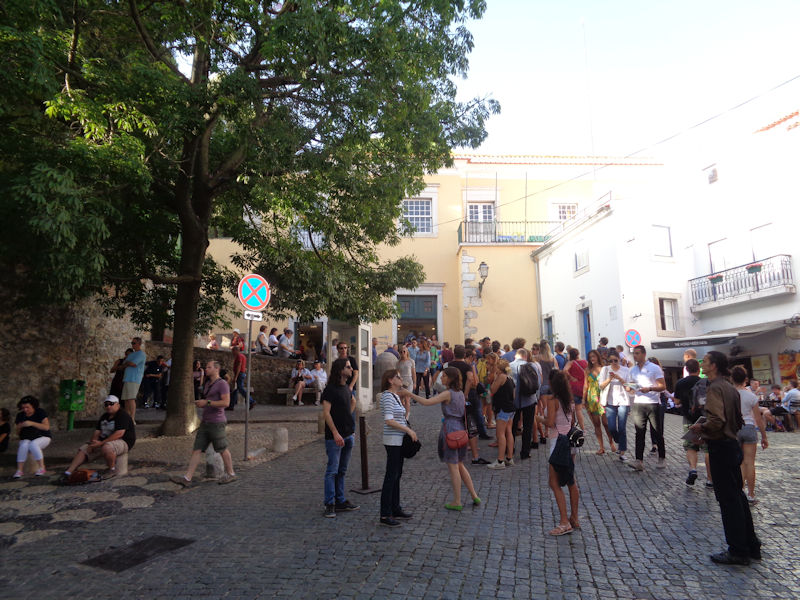
A forecourt inside the gate, leading up to the ticket office (the fee is reasonable)
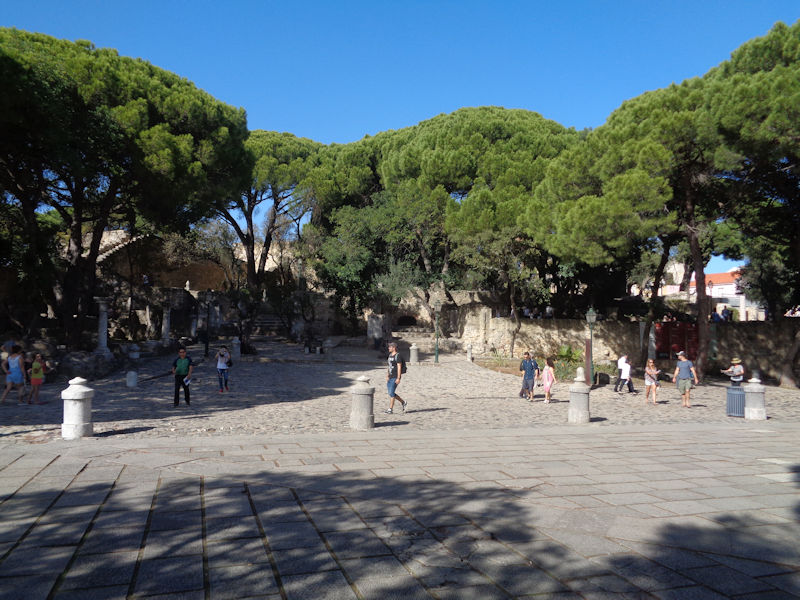
Entering the large expanse of the Miradouro, or scenic viewpoint, of the citadel, also called the Praça d'Armas or military parade ground, with unimpeded views down all along the riverfront of the old parts of the city
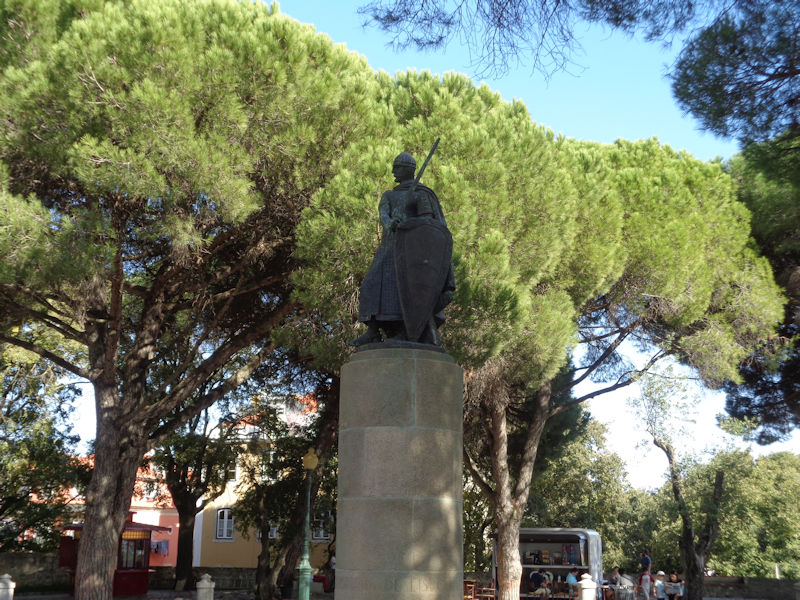
To set the right mood for our visit, here's a statue of Afonso Henriques, who convinced contingents of northern knights on their way from England to the Holy Land to fight in the Second Crusade to join him in his successful four-month 'Siege of Lisbon', which removed Moorish overlordship from most of modern Portugal and made Afonso the papally-recognized first King of Portugal.
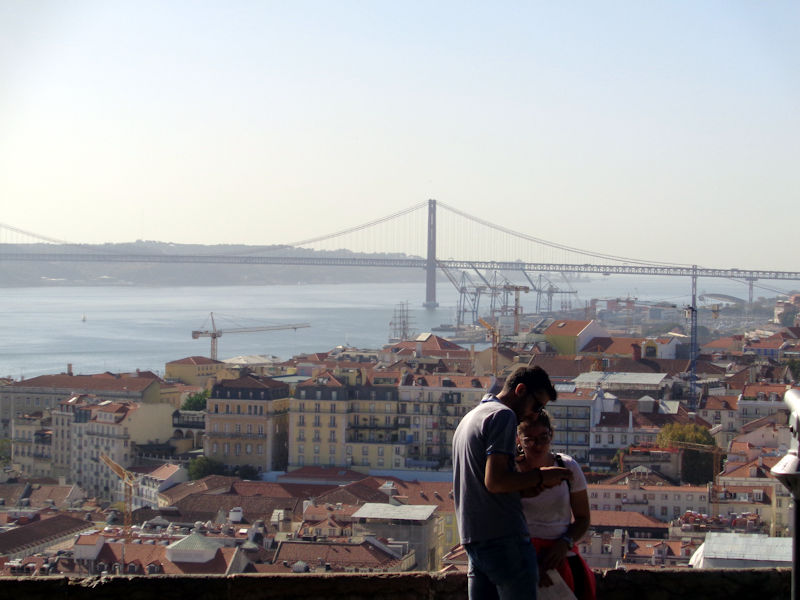
From the Miradouro, a view of the main harbor area and the 25th of April bridge

From the vast patio of the parade ground along the top of the citadel walls, we proceed up to the level of renovated remains of royal residences outside the gate of the castle itself.
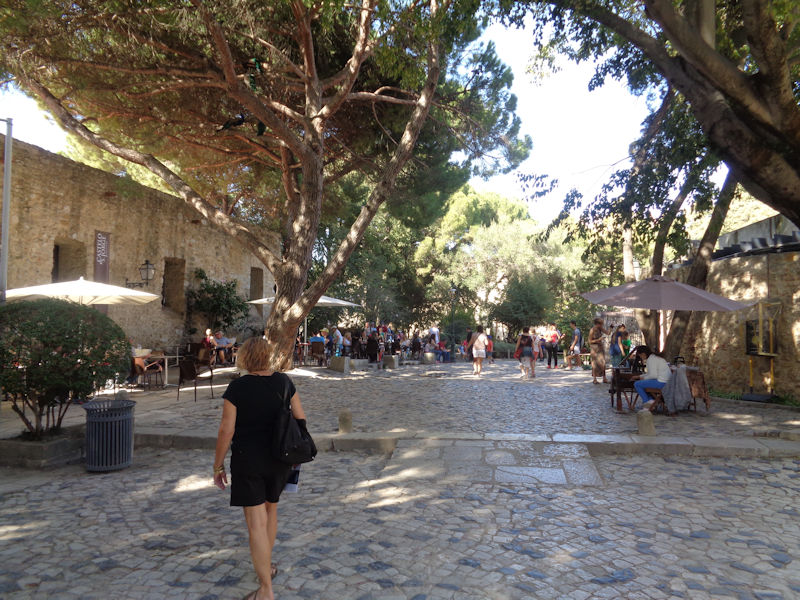
About 120 metres of pleasant promenade, formerly part of the 13th century royal residences within the citadel but outside the castle walls. The buildings presently house a restaurant and a permanent archaeological exhibition, and who knows what else.
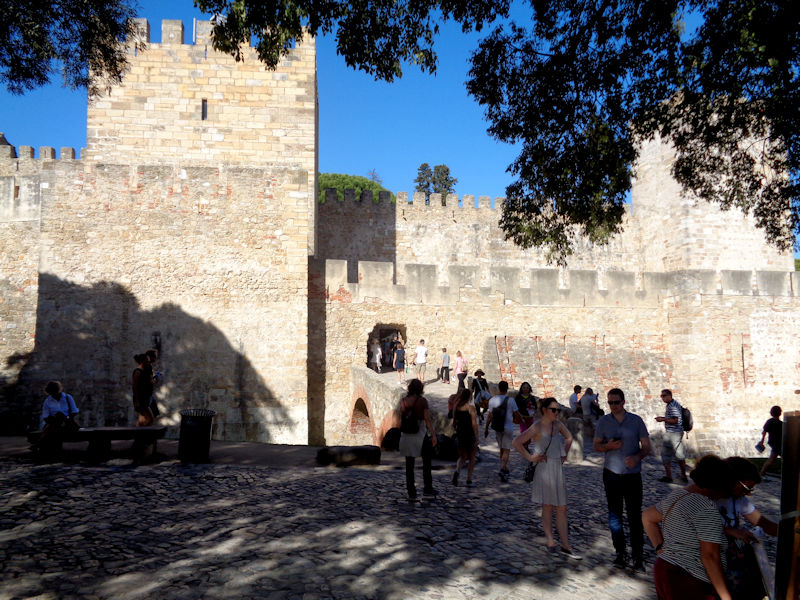
The castle door with a bridge over the now-dry moat, formerly a drawbridge
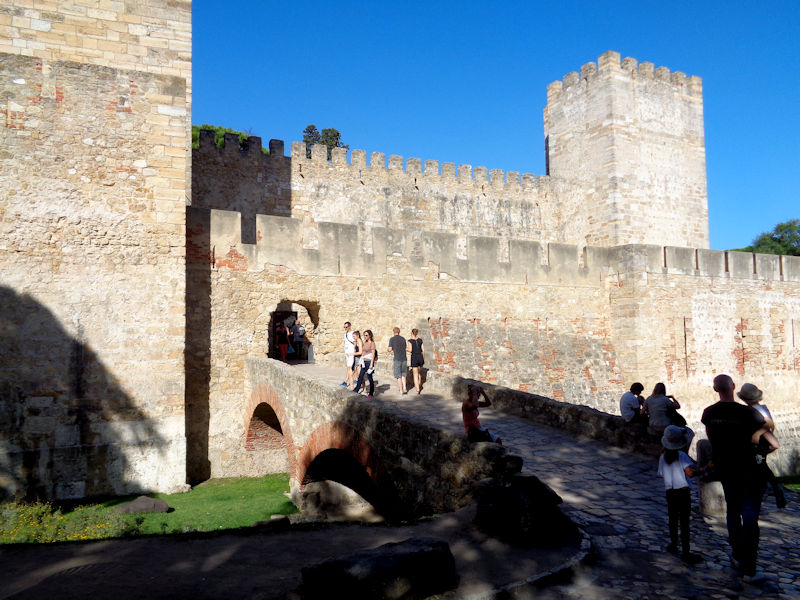
The bridge leads through a low 'barbican' wall in front of the main castle walls, intended to keep bad guys from backing siege machines right up against the main walls themselves.
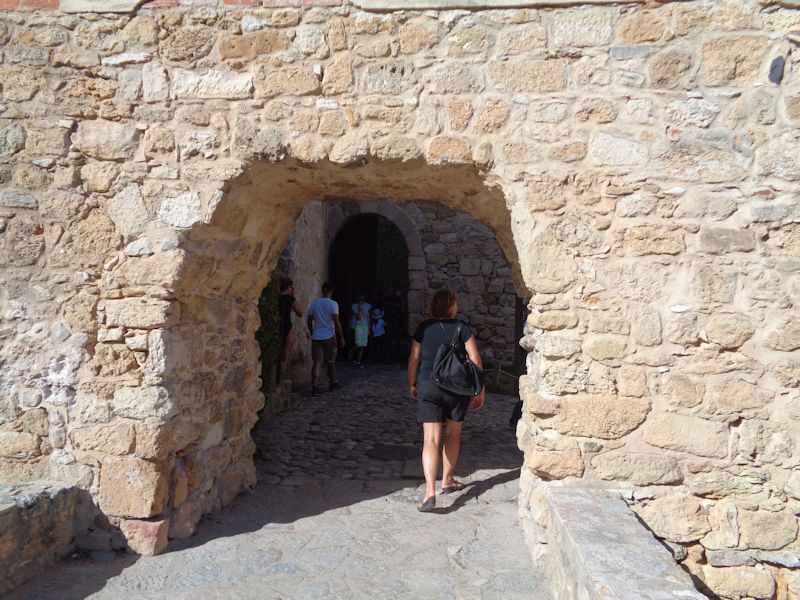
Aside from a little postern gate out the back, this is the only entrance to the castle.
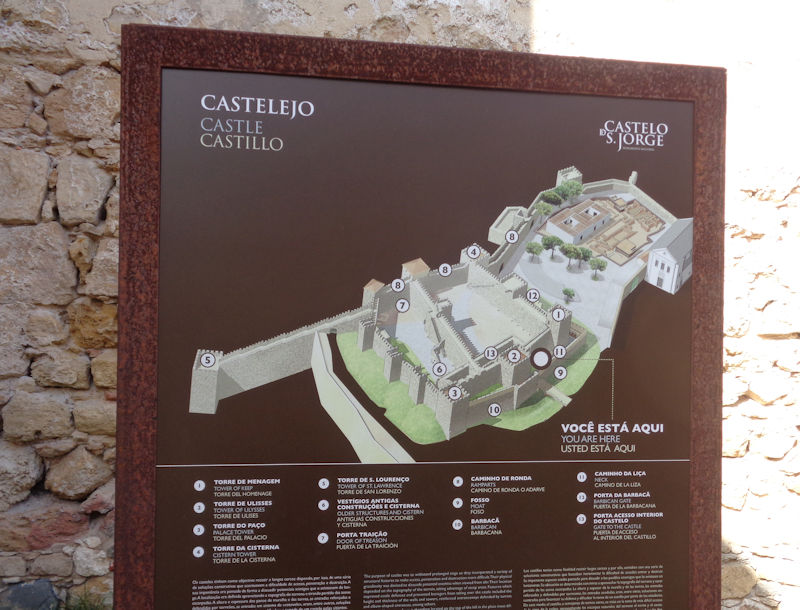
The general plan -- a nearly square castle with two main courtyards and ten towers, another surviving tower on a segment of the wall extending down the steep hillside, and in the upper right, an archaeological site still within an extension of the walls.
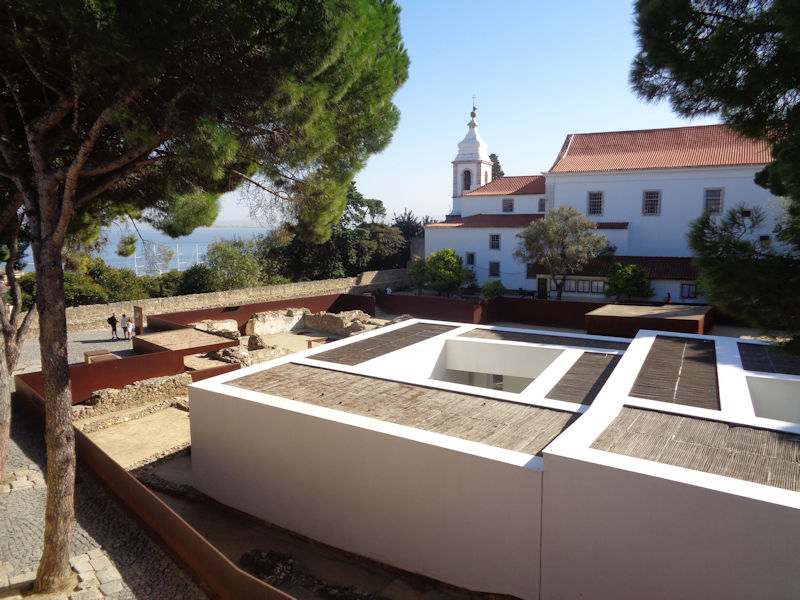
Along the ramparts walk to the archaeological site -- within the structure there are the remains of the original Moorish Quarter, where administrative elites had their residence on-site, and in the right background, in front of the Church of Santa Cruz do Castelo, there are excavations of Iron Age residences, 7th to 3rd centuries BC.
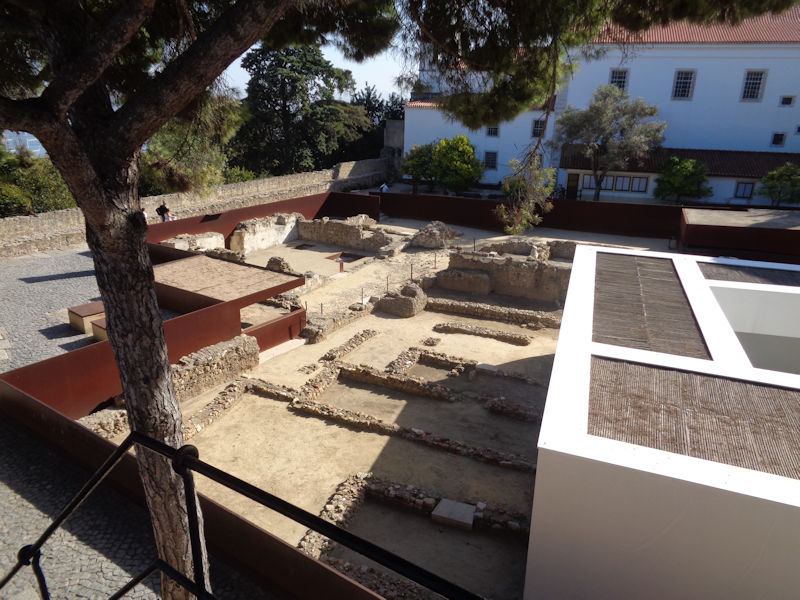
Along the wall on the left, these are the ground floor remains of the Palace of the Counts of Santiago, from the 15th to 18th centuries.
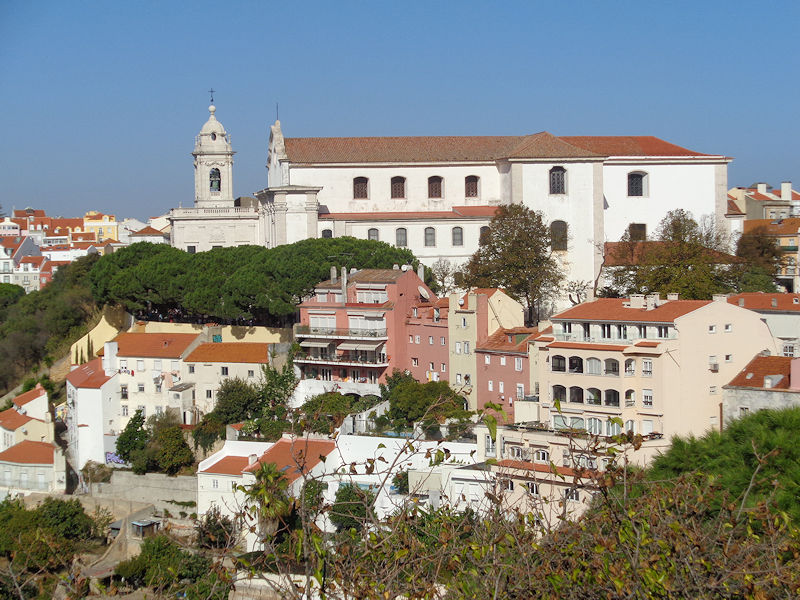
A zoom view over the way northward to the Igreja da Graça

And eastward, to the Igreja de São Vicente de Fora and, behind it, the National Pantheon

Now to get out of here -- up onto the crowded ramparts
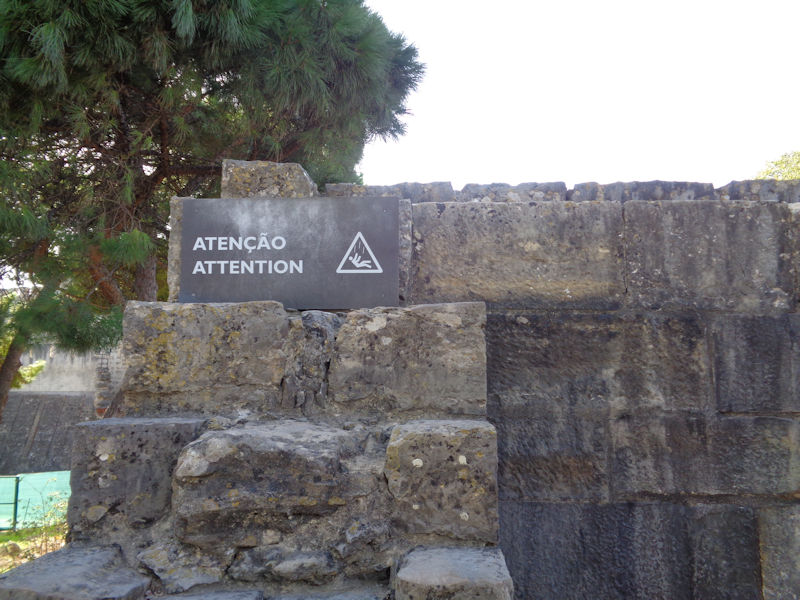
No kidding!
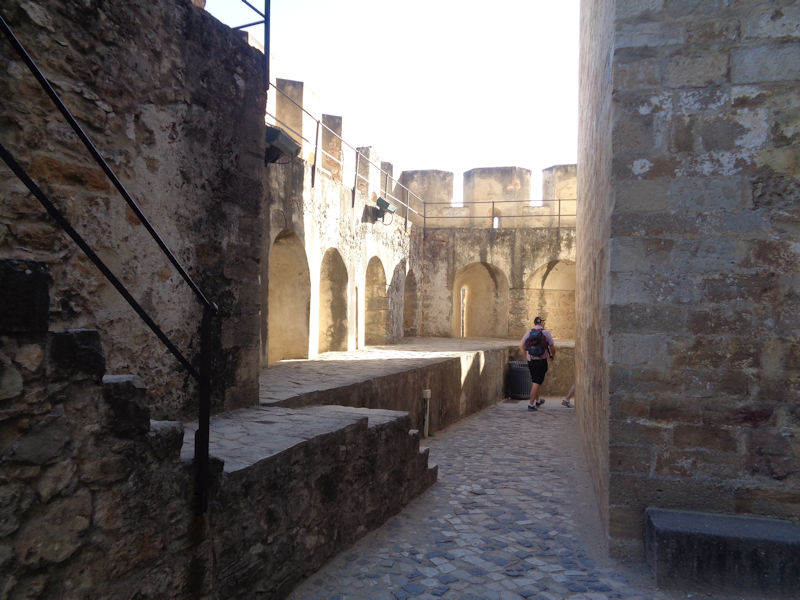
The narrow passage between the lower outer or barbican wall and the main castle wall on the right -- we're heading back around to the main entrance.
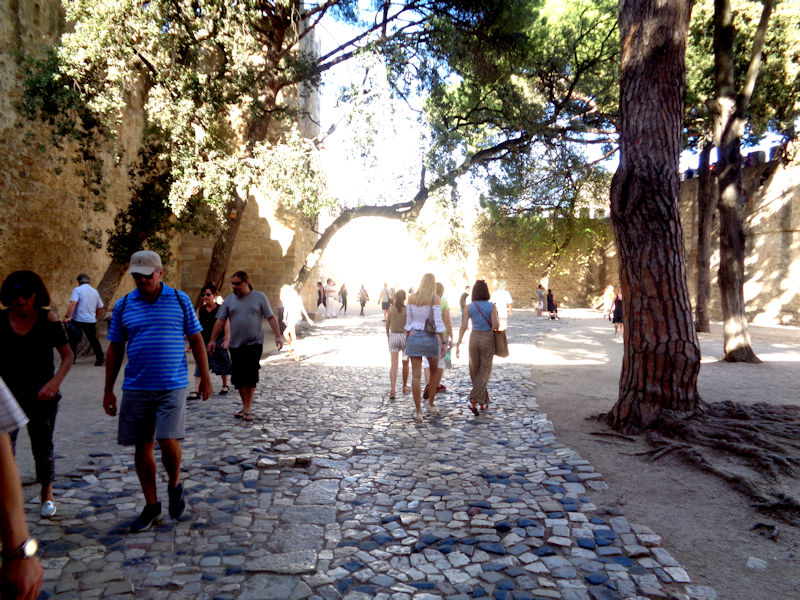
Through the main gatehouse and the elbow passage opening through another gate onto the main courtyard
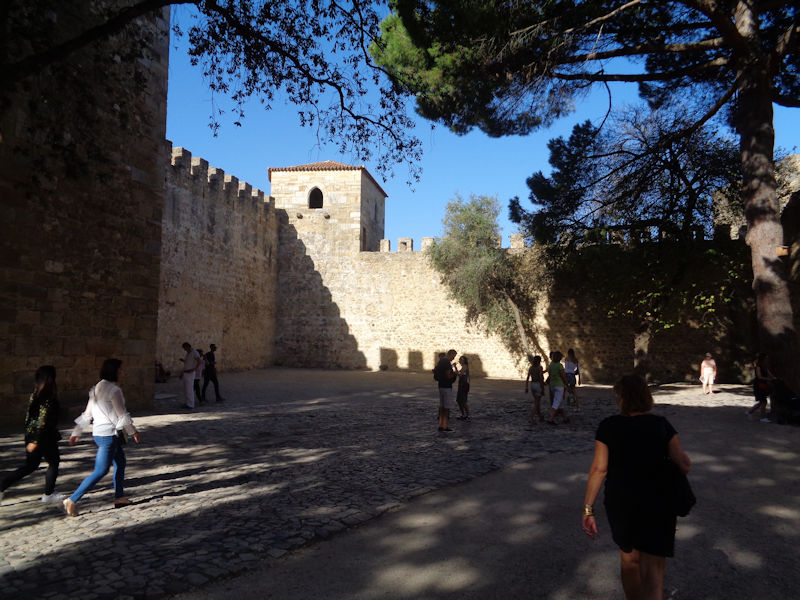
There are two courtyards -- this larger one, with a gate into a smaller one, where there are also some remains of a 15th century palace where evidently two lions were housed. There are three stairways up to the ramparts, one in the main court, two in the smaller one.
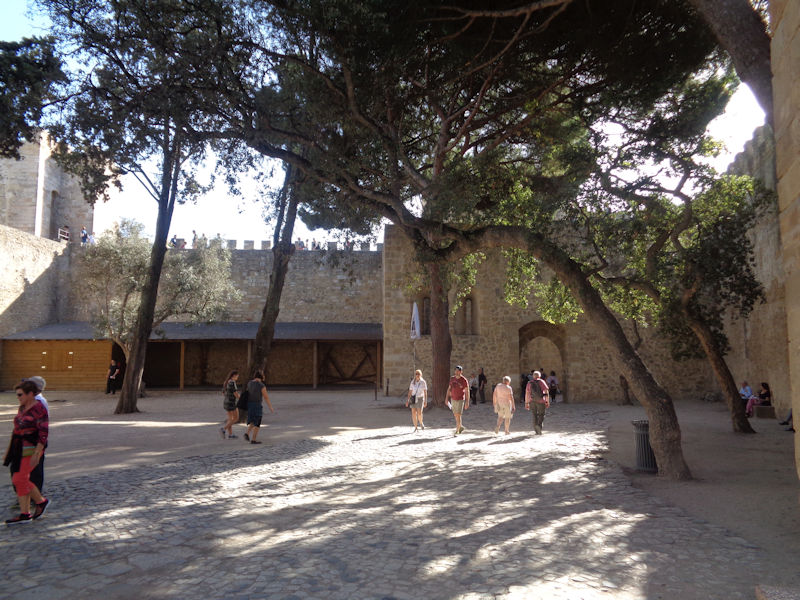
The main courtyard and gatehouse
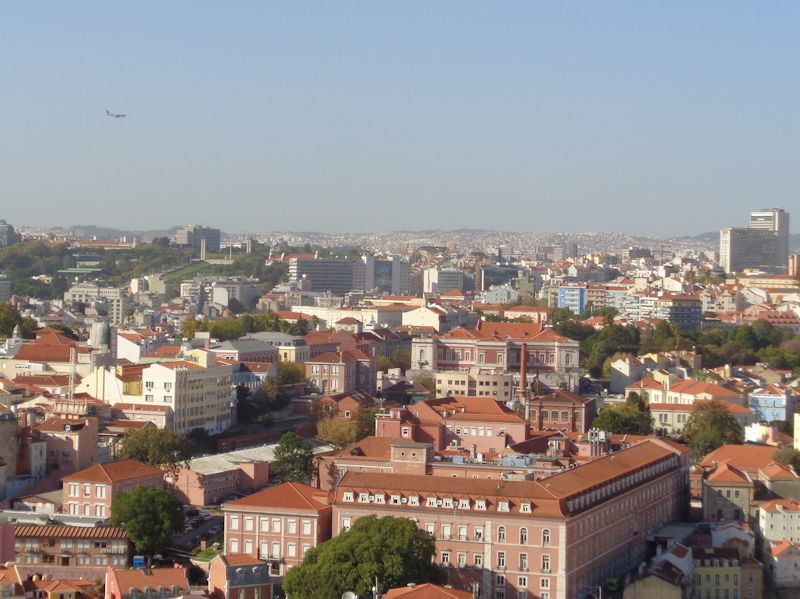
Looking northward, with an airplane coming into the Lisbon airport

The scary remains of the Carmo church and convent, dating from ca. 1400 but largely destroyed in the earthquake of 1755; the nave was never repaired and was further damaged in another earthquake in 1969. The adjacent convent has had various chiefly military uses. During the Carnation Revolution of 1974, President Caetano and his last loyalists held out briefly here before he was flown off to exile in Brazil.
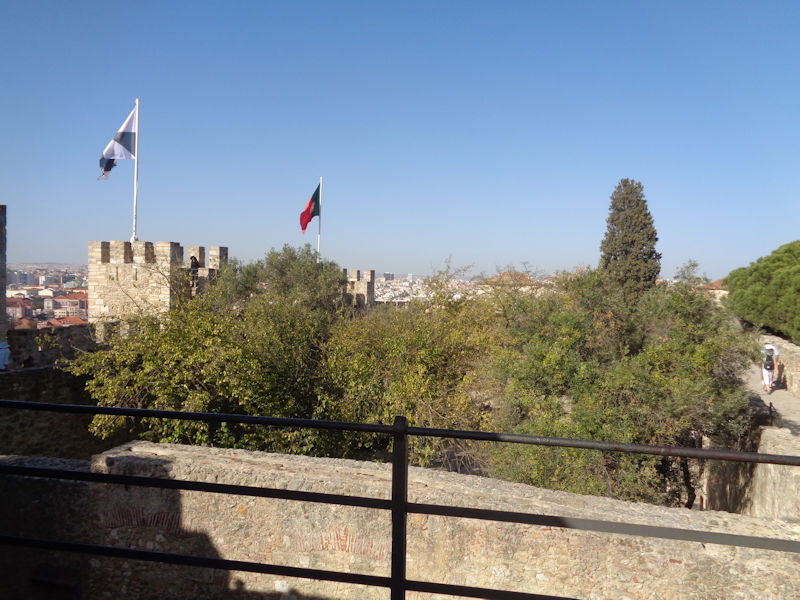
A view on the walls
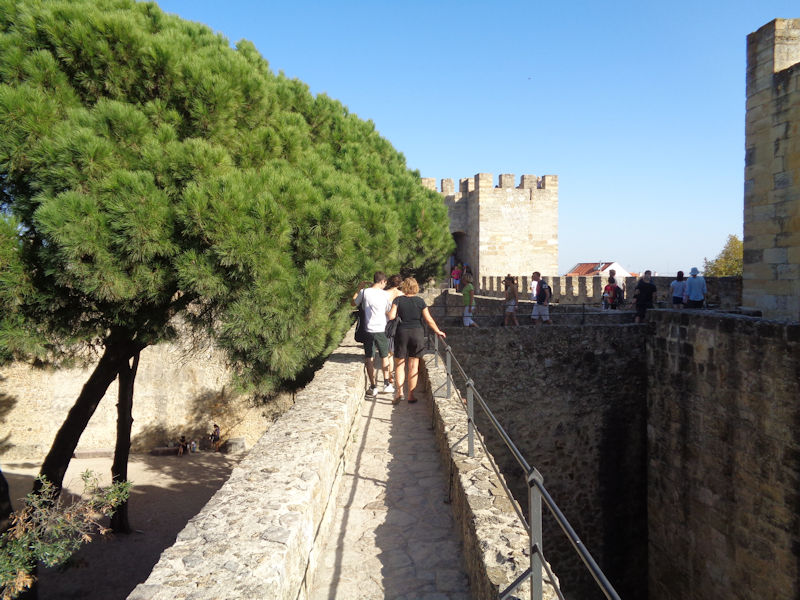
A traffic jam on the walls (imagine it in August)
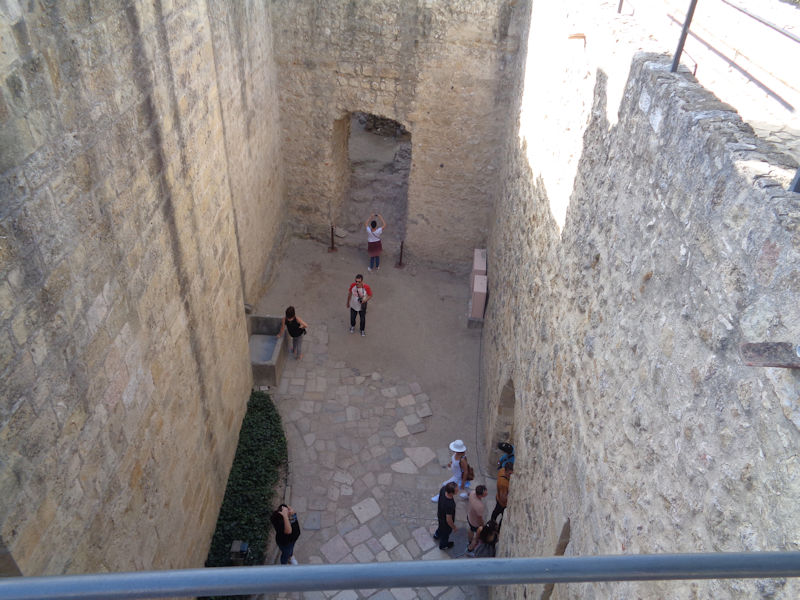
The elbow passage between the outer gate (at the bottom left) and the inner gate on the right
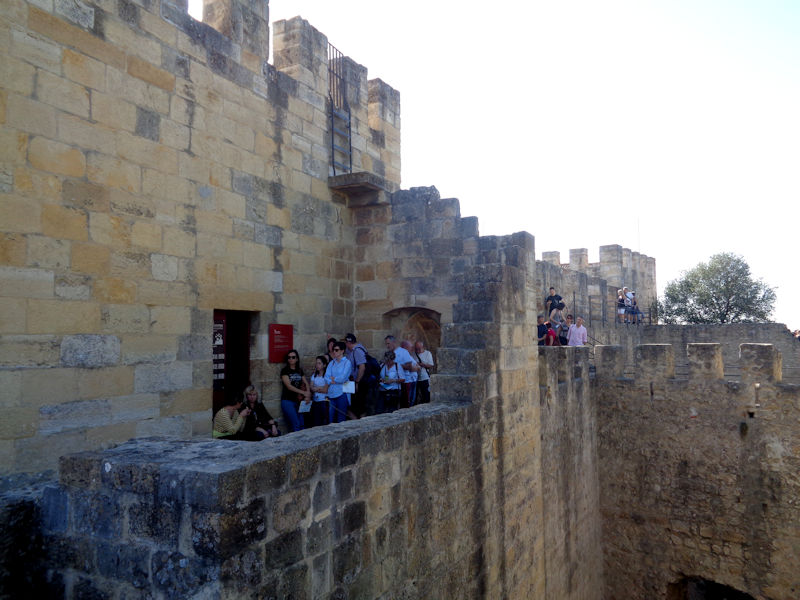
Crowds over the main gatehouse waiting to get into the 'Camera Obscura', a contempoary invention which 'with lenses and mirrors provides 360° detailed views of the city in real time'. We gave it a miss.
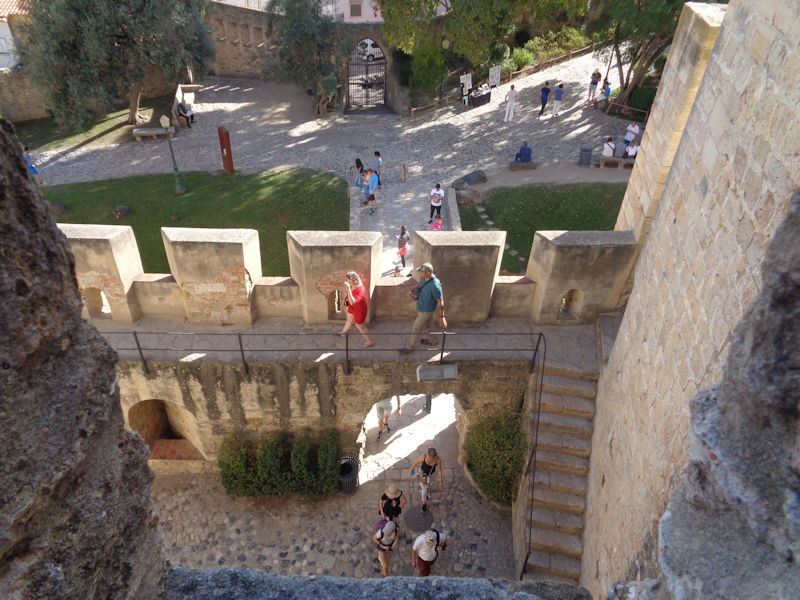
The front gate
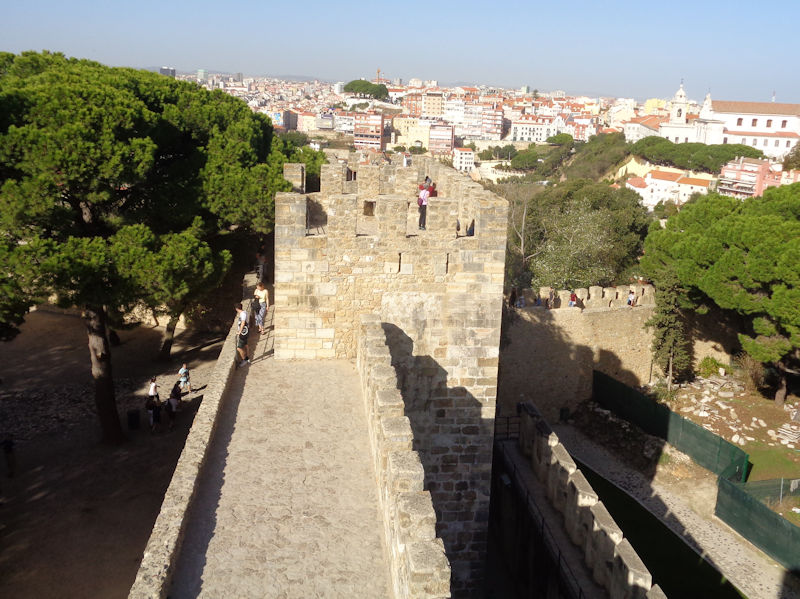
The Cistern Tower . . .
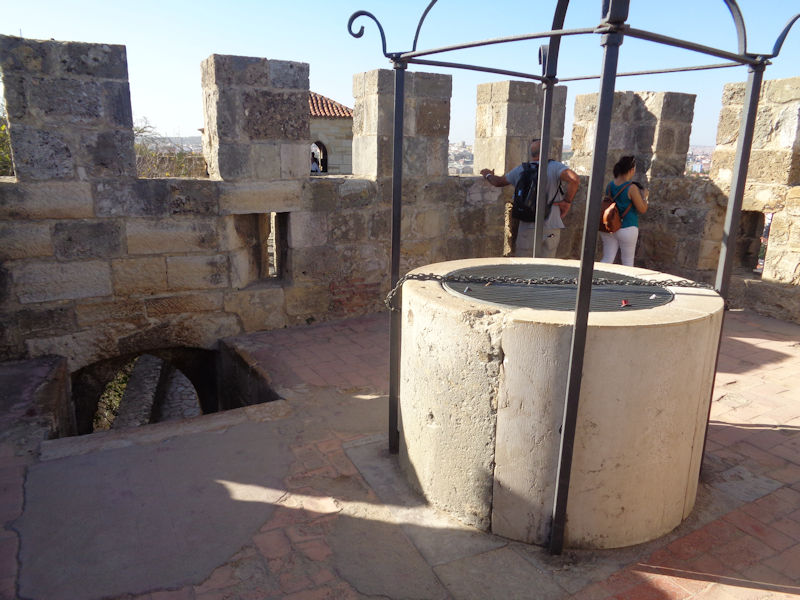
. . . with its cistern for storing rainwater
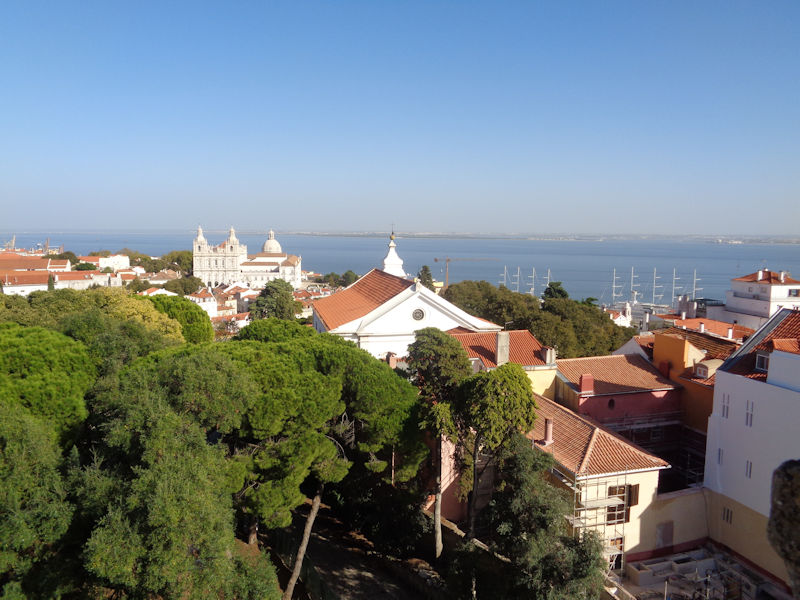
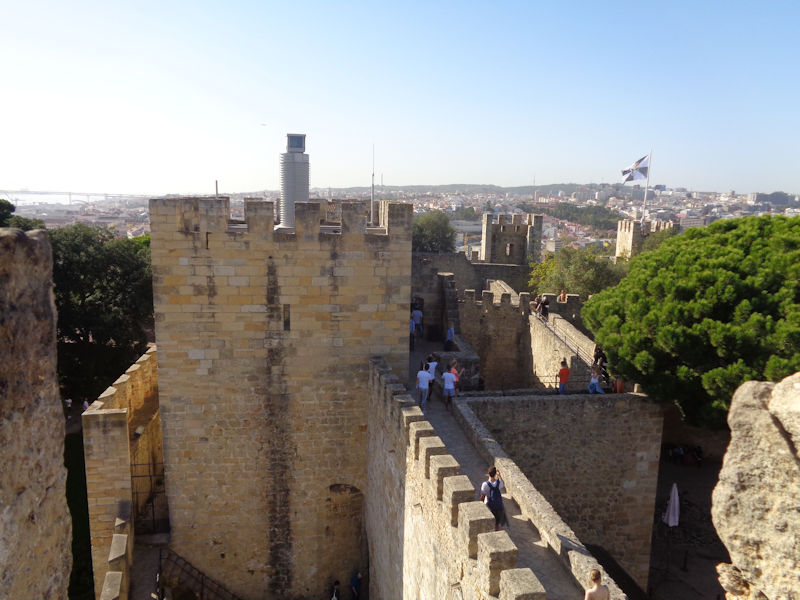
The main gatehouse (called the Tower of Riches or the Archives Tower) from the Cistern Tower
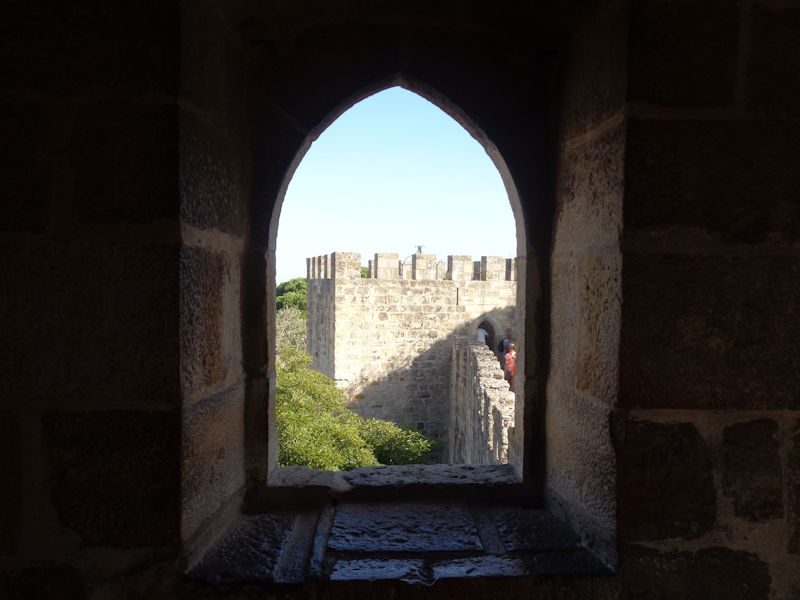
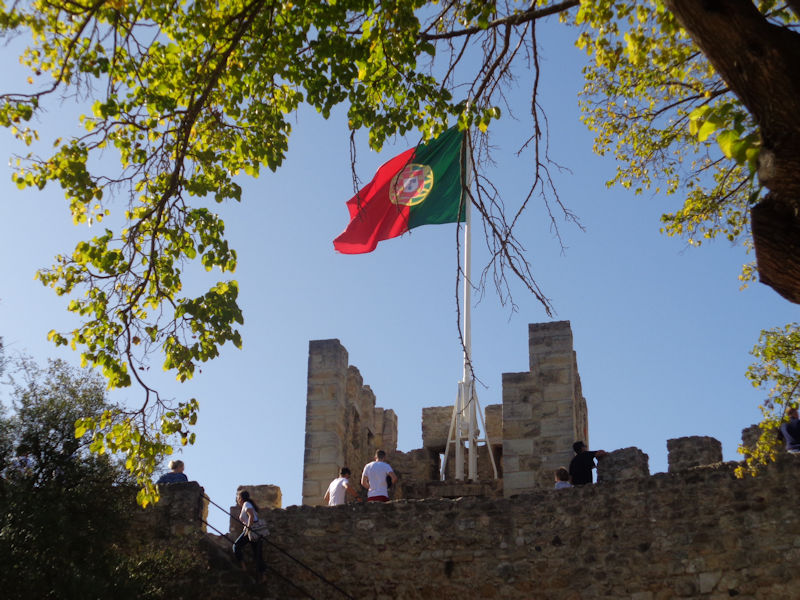
The national flag flapping proudly

And back out again. That was fun.
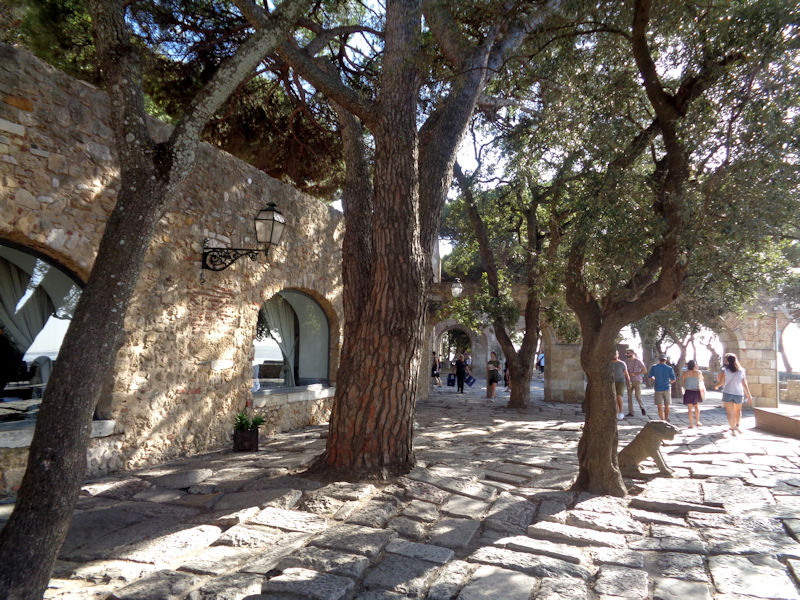
The back side of the restaurant, facing out over the outermost wall of the citadel
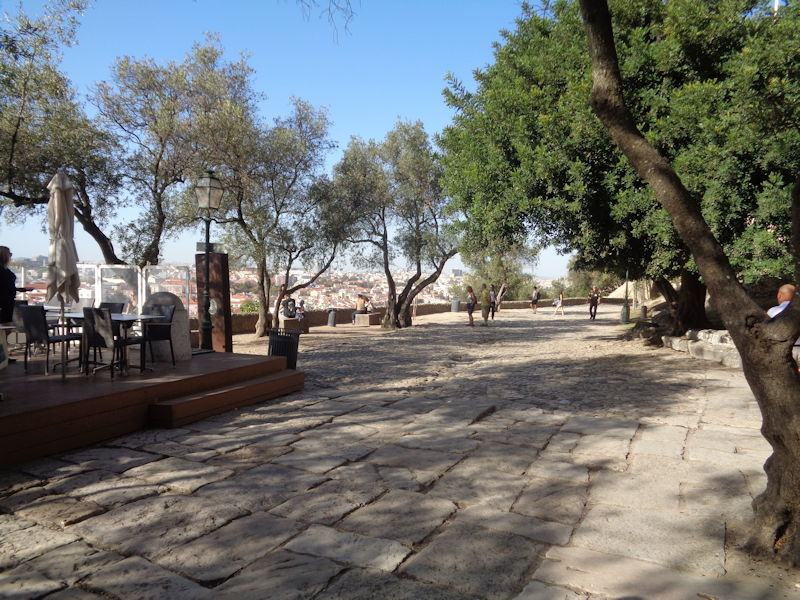

The various arches are remnants of the royal palace destroyed in the earthquake
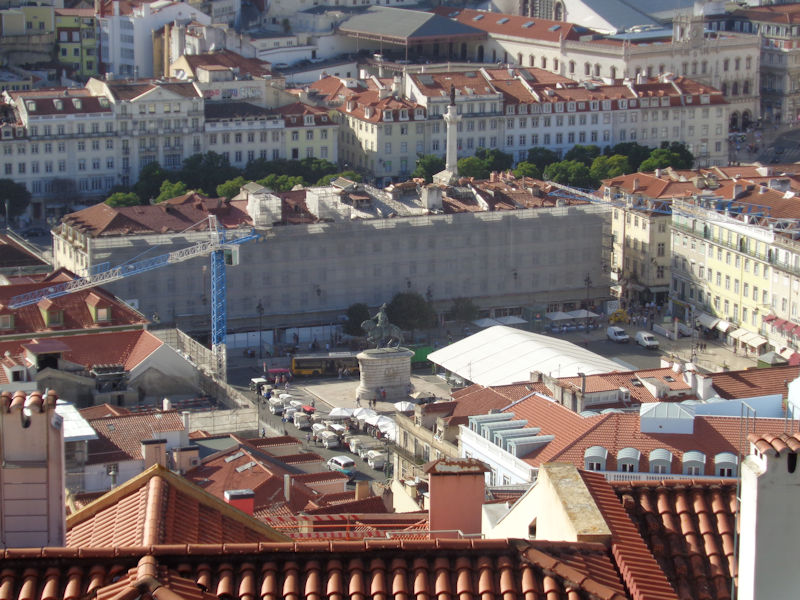
A zoom down into the Figueira Square, with its equestrian statue of King João I (King John I, who reigned 1385–1433). It was he who, with the commander Nuno Álvares Pereira ('The Constable'), turned back the Castilian invasion, with English support. To cement his anti-Castilian alliance with England, in 1387 he married John of Gaunt's well-educated daughter Philippa of Lancaster, tutored by Chaucer, Froissart, and Wycliffe, amongst others. In the line of trees behind the central building is the Praça Rossio -- the central Rossio rail station is at the upper right (we'll pass by there tomorrow).
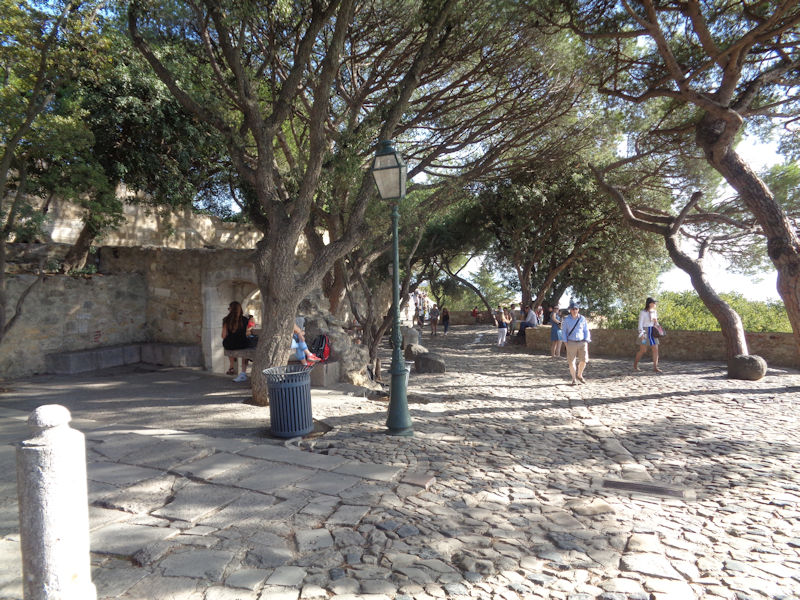
Another view of the esplanade atop the citadel wall. It was King John I who named this castle after St George, the Crusader saint and martyr and patron saint of England, presumably in honor of his wife Philippa and his alliance with England in the Treaty of Windsor (1386).
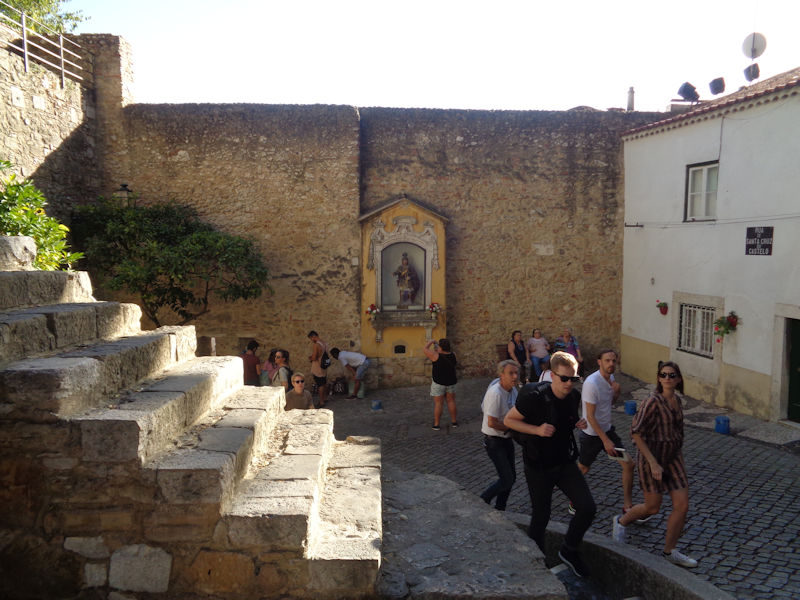
Out through the lower gate and . . .
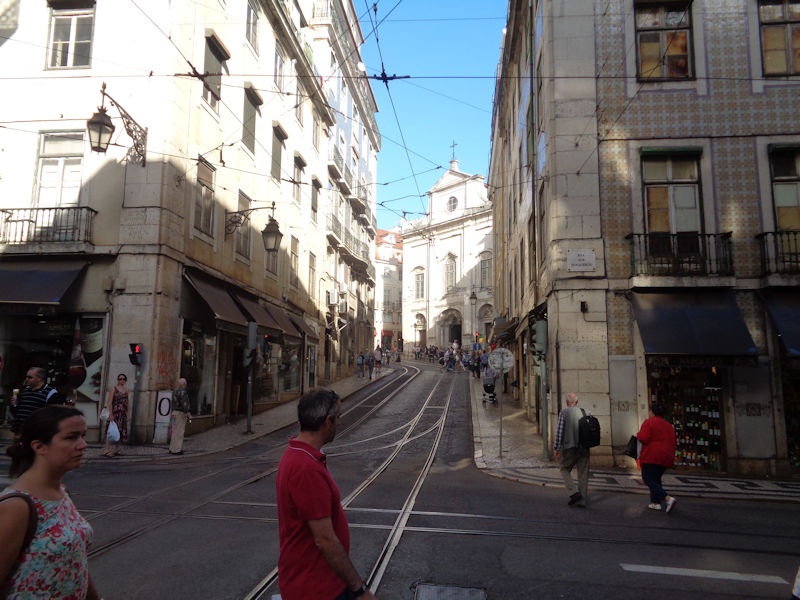
. . . fast down the hill thanks to the convenient Elevador do Pingo Doce (three stories down into the Pingo Doce supermarket). Thence down past the
Igreja da Madalena and along the Rua da Conceição to join the . . .
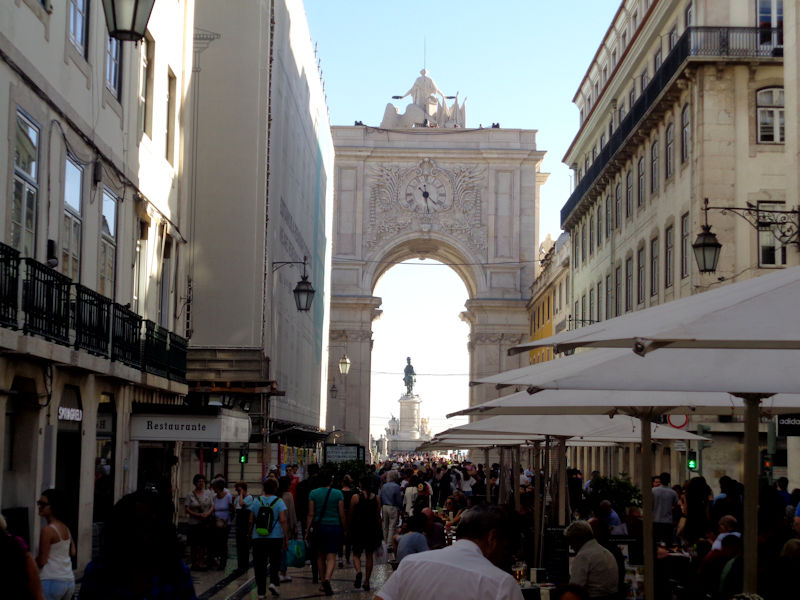
. . . major promenade for shopping and the evening passeggiata, the Rua Augusta, leading out through the Arch of Rua Augusta onto the huge Praça do Comércio and riverfront, all a product of recovery after the 1755 earthquake. (We'll get a better view of that equestrian statue of King João I when we pass back this way in a few days.)
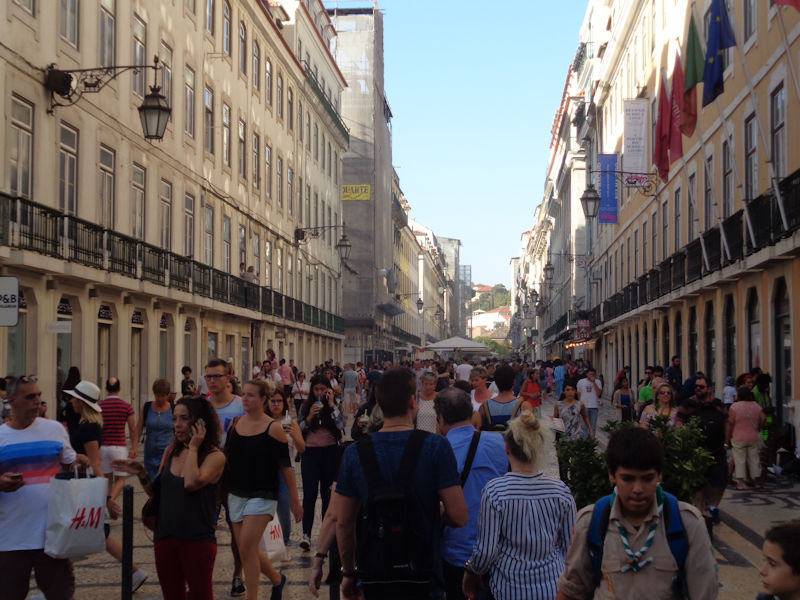
The pedestrian Rua Augusta runs more than 500m from the Arch to the Praça Rossio near the main rail station. Following the earthquake, the existing central area of the city here was razed and a new rectangular city plan laid out under the prime minister, the first Marquis of Pombal, along this axis between the Rossio and Comércio plazas.
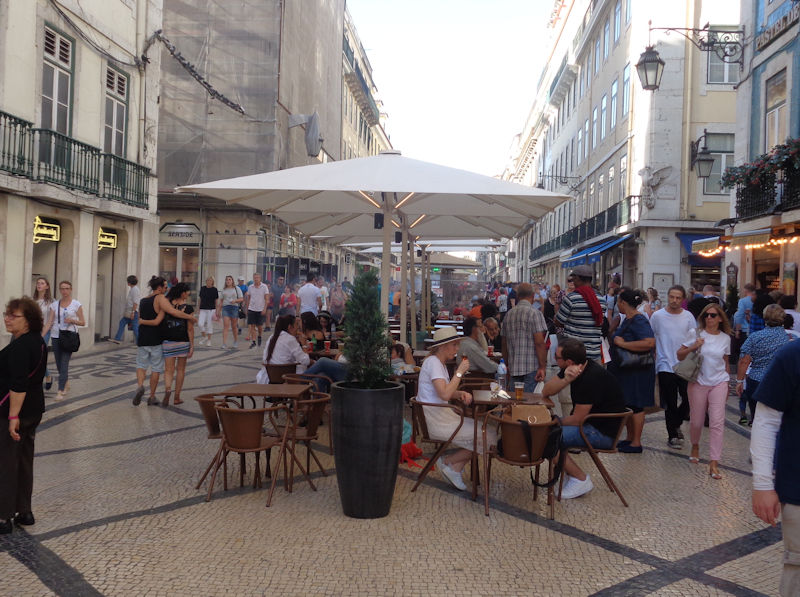
A carefree and fine summer's day (at the very end of October)
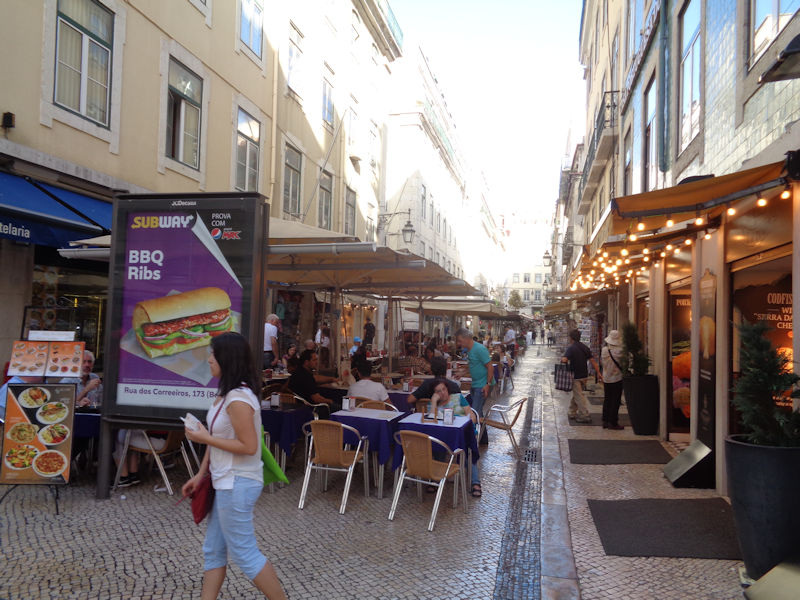
US culture is ubiquitous these days; a barbecued ribs sandwich, yum, with many extra paper napkins.
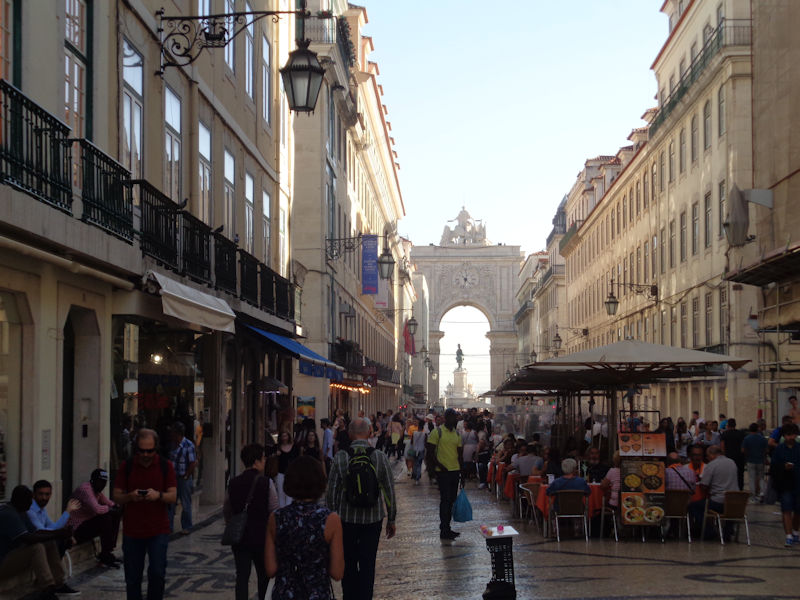
The Arch from farther up the street
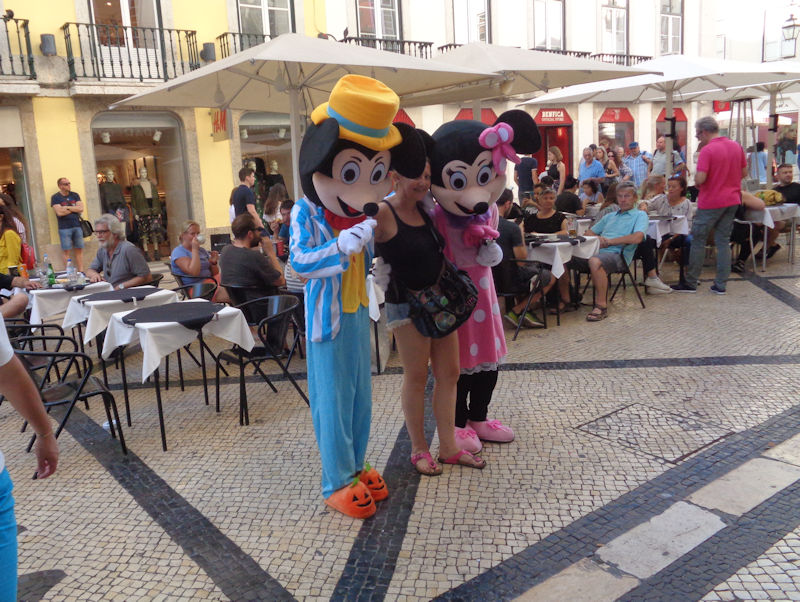
Surely a hard way to make a living
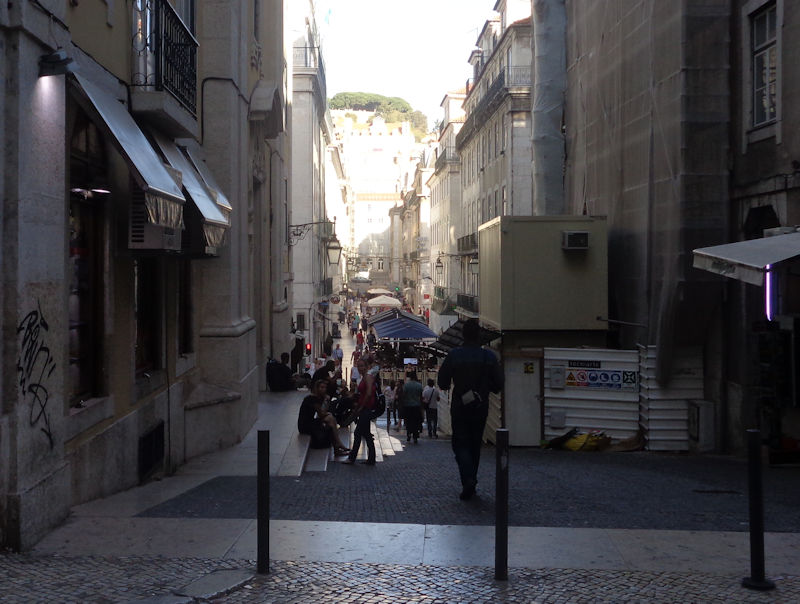
Near this point in the long day, the casual window-shoppers and the earnest uphill walkers part company, with a promise to meet up later.
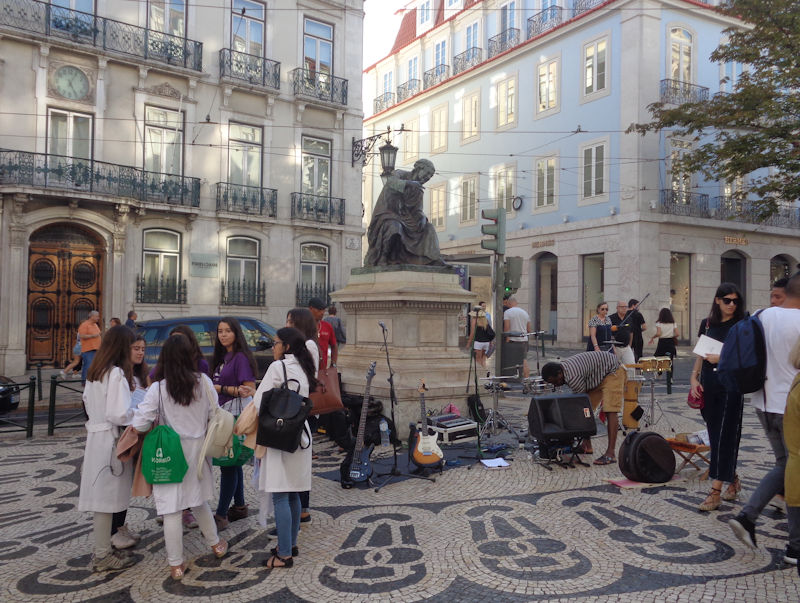
Plunging up Garrett Street to the Largo do Chiado, past a statue that can bear no more of the impromptu musical experience (it's actually meant to be the 16th century satirial poet Ribeiro, nicknamed 'Chiado'), near the . . .
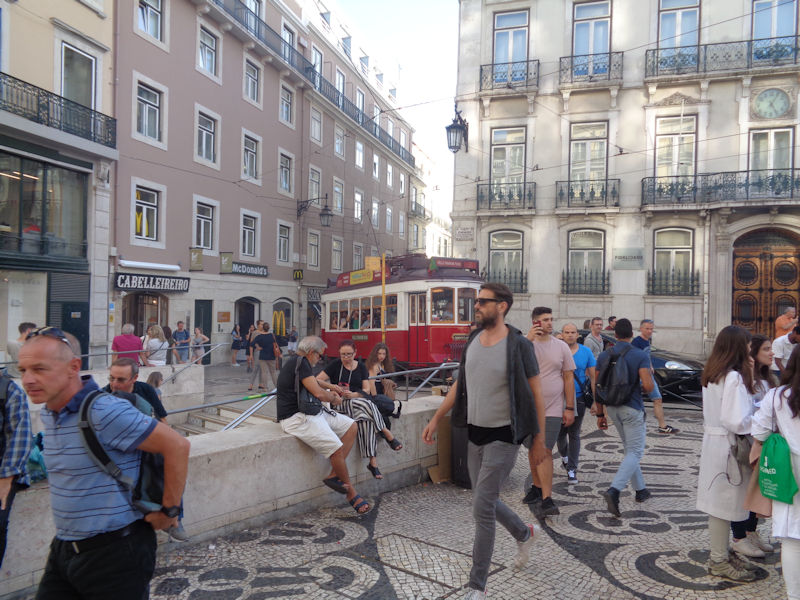
. . . Baixa-Chiado metro underground stop.

Past the now-familiar Largo Luís de Camões without even missing a stride, and up the Rua da Misericórdia (that's a side street, the Largo da Trinidade) towards Rato.
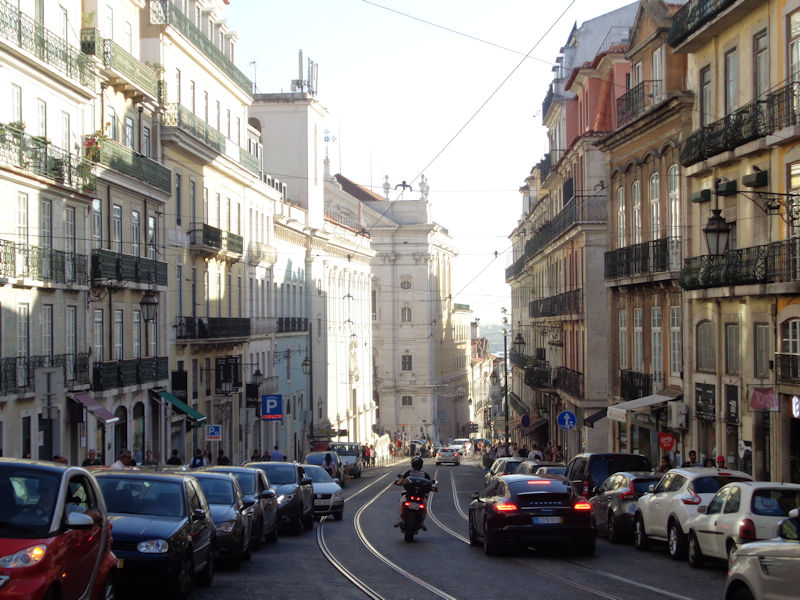
A breathless glance back down the Rua da Misericórdia

Some bronze monuments, evidently to workingmen, in front of the Igreja de São Roque
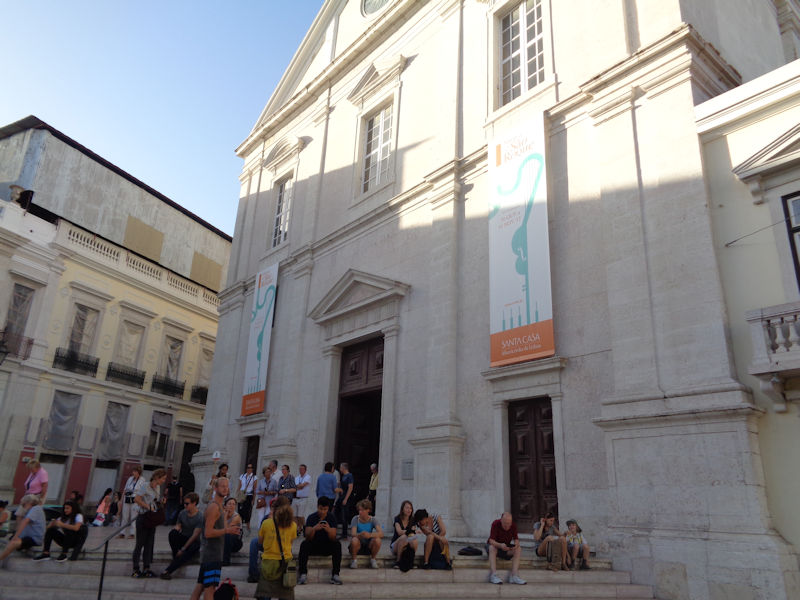
The 16th century Igreja de São Roque, or Church of San Rocco (St Roch), one of the first Jesuit churches anywhere. The site, then outside the city walls, served as a cemetery for plague victims in 1505. King Manuel I requested from Venice a relic of St Roch, patron saint of plague victims, and received something back, for which a shrine was built 1506-1515. When King John III invited the new order of the Jesuits to set up shop in Lisbon, in 1540, the good fathers soon wanted the shrine for their HQ, and then expanded it into the present edifice, completed near the end of the century, with the condition that it should include a new chapel for St Roch and retain its dedication.
It was one of a few buildings in this part of town to escape serious damage in the 1755 earthquake, but after the expulsion of Society of Jesus from Portugal (for sedition) in 1759, the property was turned over to the Santa Casa da Misericórdia (Lisbon Charity House), which still owns it and operates a museum to St Roch next door. The interior is mostly 18th century and is very . . . ermm . . . ornate.
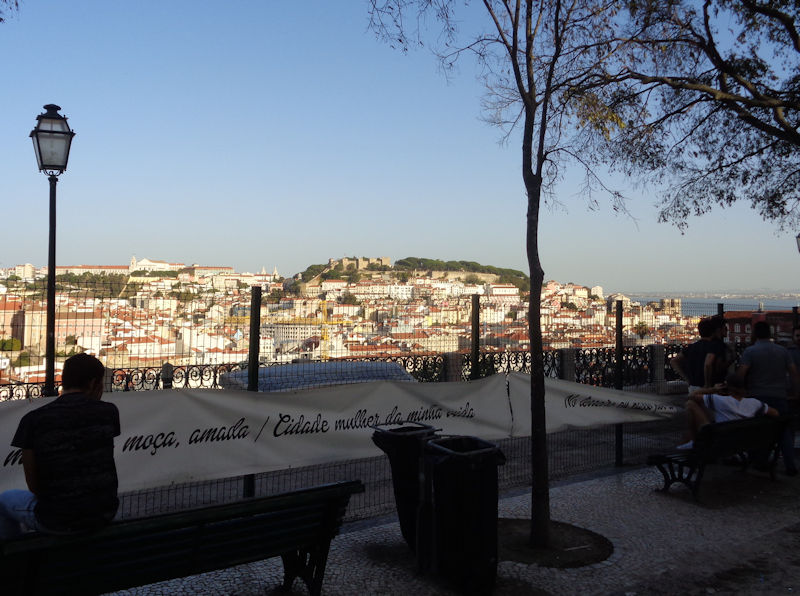
Another breather at the Miradouro de São Pedro de Alcântara, with views of the Castle of St George, whence we've just come
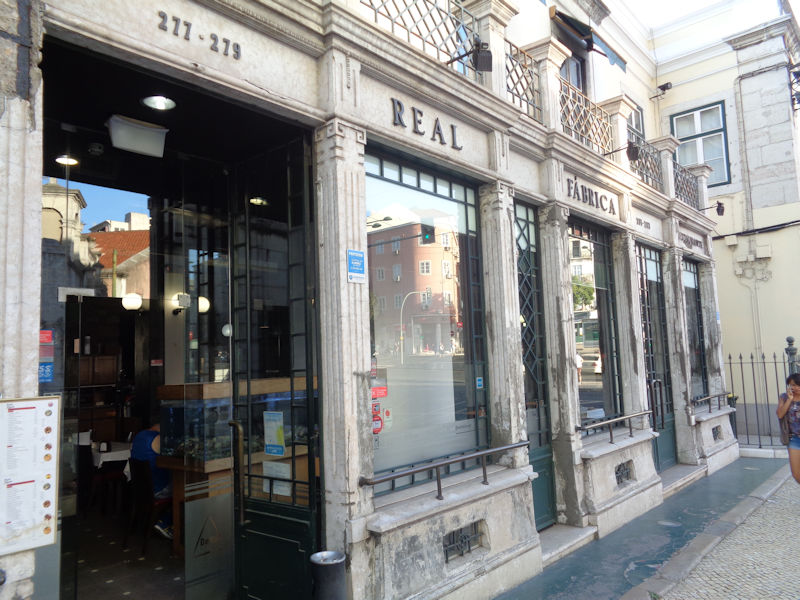
Back to the Largo do Rato and the nearby restaurant Real Fabrica, where very soon we shall be poring over the menus excitedly
Tomorrow: Sintra








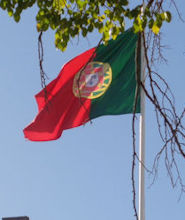 Dwight Peck's personal website
Dwight Peck's personal website























































